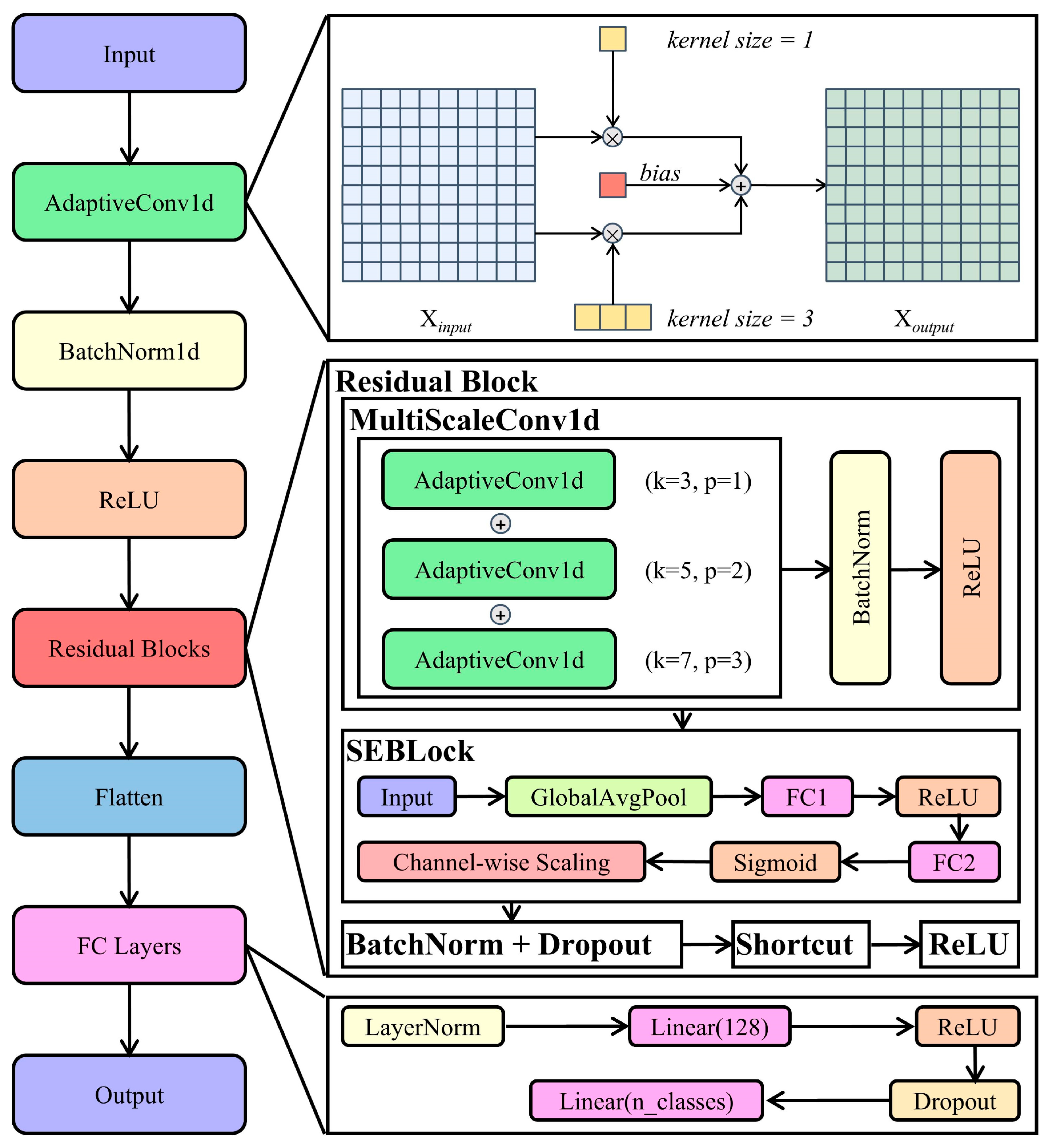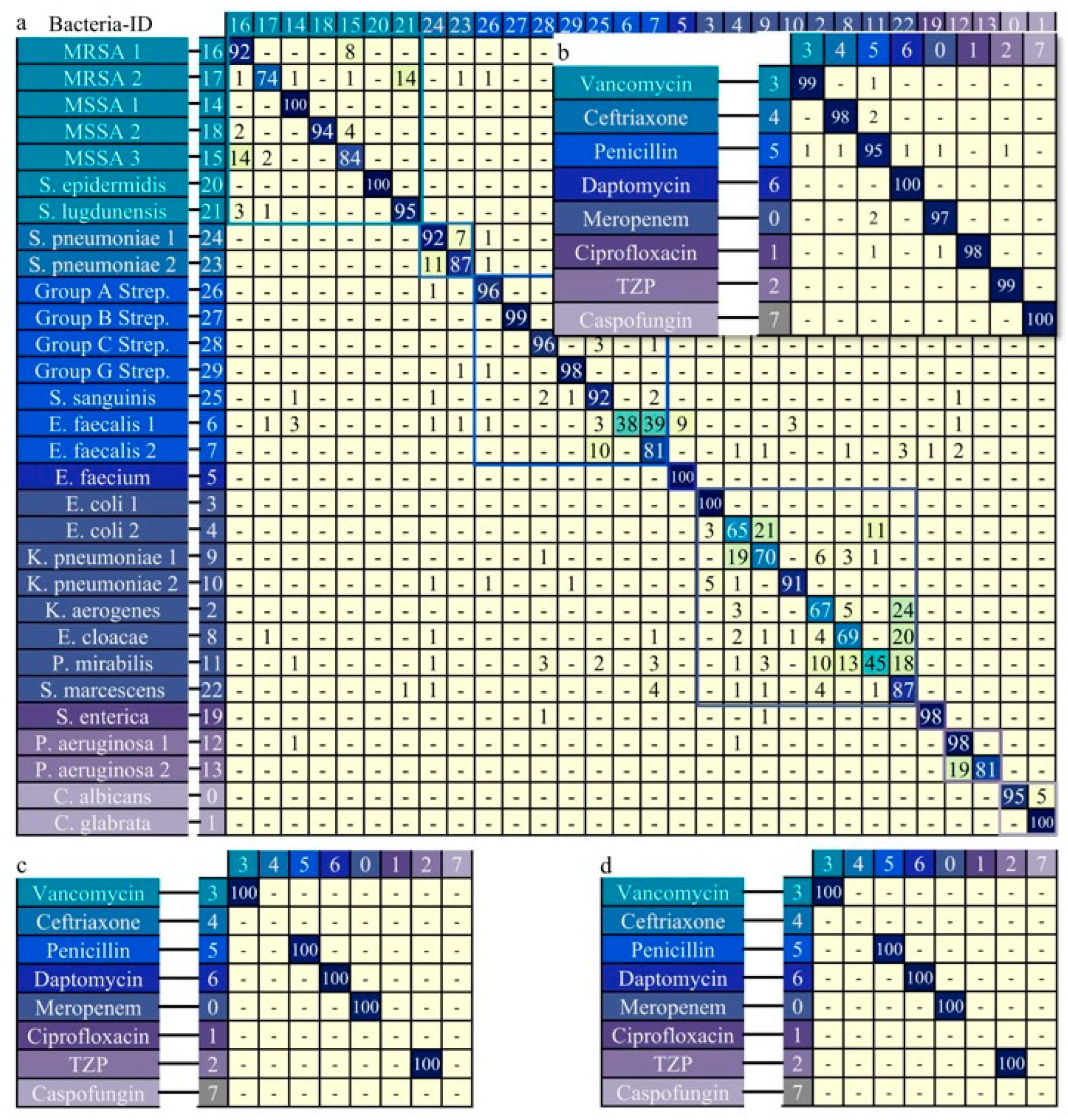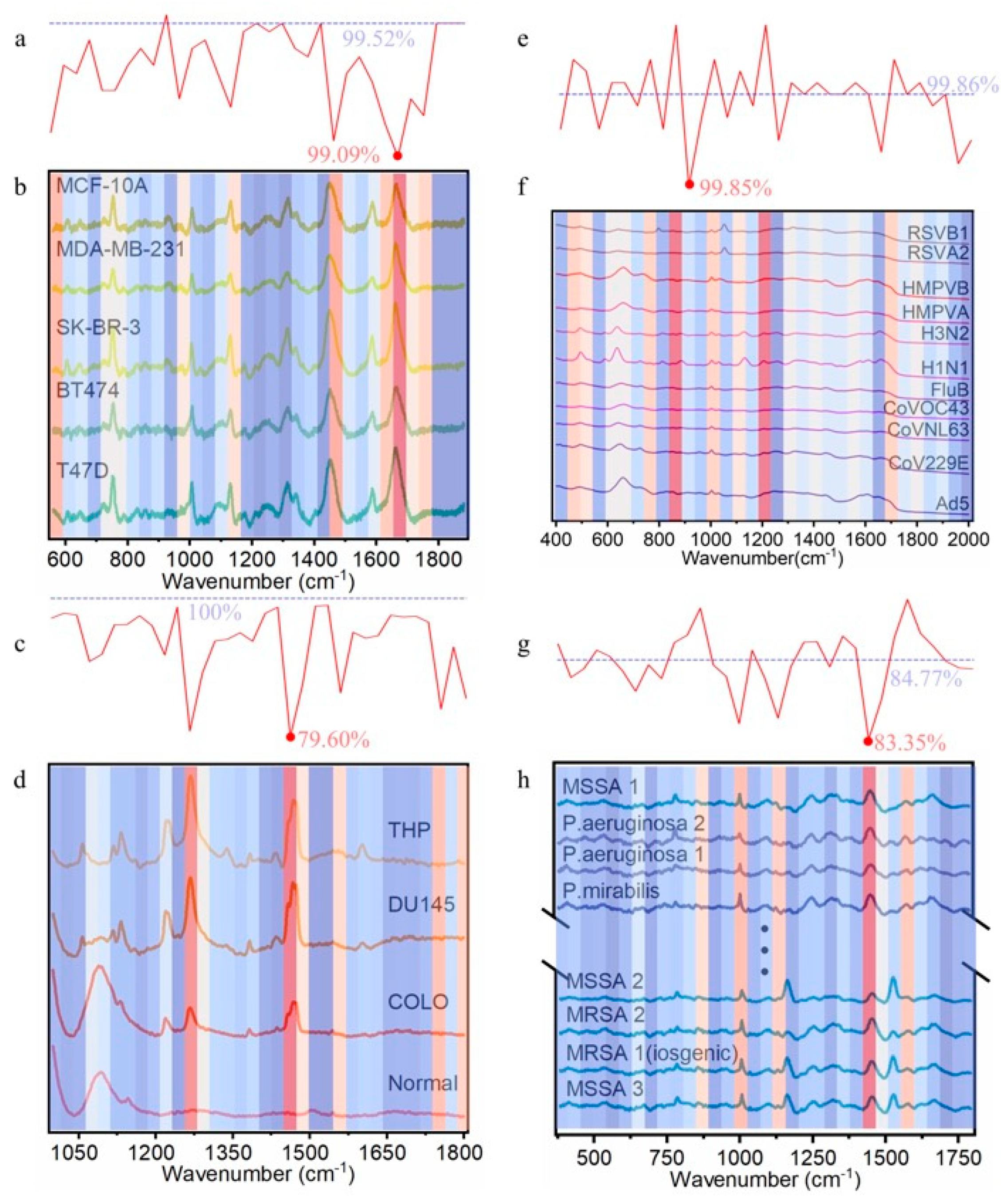BioRamanNet: A Neural Network Framework for Biological Raman Spectroscopy Classification
Abstract
1. Introduction
2. Materials and Methods
2.1. Spectra Analysis Strategy
2.2. Dataset
2.3. Construction of the BioRamanNet
2.4. Training and Testing Details
3. Results
3.1. Classification Performance of the BioRamanNet
3.2. Comparative Analysis and Ablation Study
3.3. Analysis of the Spectral Interpretability
4. Discussion
5. Conclusions
Supplementary Materials
Author Contributions
Funding
Institutional Review Board Statement
Data Availability Statement
Acknowledgments
Conflicts of Interest
Abbreviations
| t-SNE | t-distributed Stochastic Neighbor Embedding |
| UMAP | Uniform Manifold Approximation and Projection |
| ResNet | Residual Network |
| AdaptiveConv1D | Adaptive Convolutional 1D |
| ReLU | Rectified Linear Unit |
References
- Dellinger, R.P.; Levy, M.M.; Rhodes, A.; Annane, D.; Gerlach, H.; Opal, S.M.; Sevransky, J.E.; Sprung, C.L.; Douglas, I.S.; Jaeschke, R.; et al. Surviving Sepsis Campaign: International Guidelines for Management of Severe Sepsis and Septic Shock: 2012. Crit. Care Med. 2013, 41, 580–637. [Google Scholar] [CrossRef]
- Chaudhuri, A.; Martin, P.M.; Kennedy, P.G.E.; Andrew Seaton, R.; Portegies, P.; Bojar, M.; Steiner, I. EFNS guideline on the management of community-acquired bacterial meningitis: Report of an EFNS Task Force on acute bacterial meningitis in older children and adults. Eur. J. Neurol. 2008, 15, 649–659. [Google Scholar] [CrossRef]
- Gouel-Cheron, A.; Lumbard, K.; Hunsberger, S.; Arteaga-Cabello, F.J.; Beigel, J.; Belaunzarán-Zamudio, P.F.; Caballero-Sosa, S.; Escobedo-López, K.; Ibarra-González, V.; Nájera-Cancino, J.G.; et al. Serial real-time RT-PCR and serology measurements substantially improve Zika and Dengue virus infection classification in a co-circulation area. Antivir. Res. 2019, 172, 104638. [Google Scholar] [CrossRef]
- Qian, Y.; Fan, T.; Yao, Y.; Shi, X.; Liao, X.; Zhou, F.; Gao, F. Label-free and Raman dyes-free surface-enhanced Raman spectroscopy for detection of DNA. Sens. Actuators B Chem. 2018, 254, 483–489. [Google Scholar] [CrossRef]
- Barucci, A.; D’Andrea, C.; Farnesi, E.; Banchelli, M.; Amicucci, C.; de Angelis, M.; Hwang, B.; Matteini, P. Label-free SERS detection of proteins based on machine learning classification of chemo-structural determinants. Analyst 2021, 146, 674–682. [Google Scholar] [CrossRef] [PubMed]
- Zhang, Y.; Chang, K.; Ogunlade, B.; Herndon, L.; Tadesse, L.F.; Kirane, A.R.; Dionne, J.A. From Genotype to Phenotype: Raman Spectroscopy and Machine Learning for Label-Free Single-Cell Analysis. ACS Nano 2024, 18, 18101–18117. [Google Scholar] [CrossRef]
- Langer, J.; Jimenez de Aberasturi, D.; Aizpurua, J.; Alvarez-Puebla, R.A.; Auguié, B.; Baumberg, J.J.; Bazan, G.C.; Bell, S.E.J.; Boisen, A.; Brolo, A.G.; et al. Present and Future of Surface-Enhanced Raman Scattering. ACS Nano 2020, 14, 28–117. [Google Scholar] [CrossRef]
- Moskovits, M. Persistent misconceptions regarding SERS. Phys. Chem. Chem. Phys. 2013, 15, 5301–5311. [Google Scholar] [CrossRef] [PubMed]
- Lu, X.; Samuelson, D.R.; Xu, Y.; Zhang, H.; Wang, S.; Rasco, B.A.; Xu, J.; Konkel, M.E. Detecting and Tracking Nosocomial Methicillin-Resistant Staphylococcus aureus Using a Microfluidic SERS Biosensor. Anal. Chem. 2013, 85, 2320–2327. [Google Scholar] [CrossRef]
- Butler, H.J.; Ashton, L.; Bird, B.; Cinque, G.; Curtis, K.; Dorney, J.; Esmonde-White, K.; Fullwood, N.J.; Gardner, B.; Martin-Hirsch, P.L.; et al. Using Raman spectroscopy to characterize biological materials. Nat. Protoc. 2016, 11, 664–687. [Google Scholar] [CrossRef] [PubMed]
- Herndon, L.K.; Zhang, Y.; Safir, F.; Ogunlade, B.; Balch, H.B.; Boehm, A.B.; Dionne, J.A. Bacterial Wastewater-Based Epidemiology Using Surface-Enhanced Raman Spectroscopy and Machine Learning. Nano Lett. 2025, 25, 1250–1259. [Google Scholar] [CrossRef]
- Sahli, C.; Kenry. Enhancing Nanomaterial-Based Optical Spectroscopic Detection of Cancer through Machine Learning. ACS Mater. Lett. 2024, 6, 4697–4709. [Google Scholar] [CrossRef]
- Yin, P.; Li, G.; Zhang, B.; Farjana, H.; Zhao, L.; Qin, H.; Hu, B.; Ou, J.; Tian, J. Facile PEG-based isolation and classification of cancer extracellular vesicles and particles with label-free surface-enhanced Raman scattering and pattern recognition algorithm. Analyst 2021, 146, 1949–1955. [Google Scholar] [CrossRef] [PubMed]
- del Real Mata, C.; Jeanne, O.; Jalali, M.; Lu, Y.; Mahshid, S. Nanostructured-Based Optical Readouts Interfaced with Machine Learning for Identification of Extracellular Vesicles. Adv. Heal. Mater. 2023, 12, 2202123. [Google Scholar] [CrossRef]
- Yu, Q.; Shen, X.; Yi, L.; Liang, M.; Li, G.; Guan, Z.; Wu, X.; Castel, H.; Hu, B.; Yin, P.; et al. Fragment-Fusion Transformer: Deep Learning-Based Discretization Method for Continuous Single-Cell Raman Spectral Analysis. ACS Sens. 2024, 9, 3907–3920. [Google Scholar] [CrossRef]
- Xue, M.; Hu, J.; He, X.; Hu, J.; Li, Y.; Wang, G.; Huang, X.; Yuan, Y. Advanced Nosema bombycis Spore Identification: Single-Cell Raman Spectroscopy Combined with Self-Attention Mechanism-Guided Deep Learning. Anal. Chem. 2024, 96, 20255–20266. [Google Scholar] [CrossRef]
- Ho, C.-S.; Jean, N.; Hogan, C.A.; Blackmon, L.; Jeffrey, S.S.; Holodniy, M.; Banaei, N.; Saleh, A.A.E.; Ermon, S.; Dionne, J. Rapid identification of pathogenic bacteria using Raman spectroscopy and deep learning. Nat. Commun. 2019, 10, 4927. [Google Scholar] [CrossRef]
- Yang, Y.; Xu, B.; Haverstick, J.; Ibtehaz, N.; Muszyński, A.; Chen, X.; Chowdhury, M.E.H.; Zughaier, S.M.; Zhao, Y. Differentiation and classification of bacterial endotoxins based on surface enhanced Raman scattering and advanced machine learning. Nanoscale 2022, 14, 8806–8817. [Google Scholar] [CrossRef] [PubMed]
- Yang, Y.; Cui, J.; Luo, D.; Murray, J.; Chen, X.; Hülck, S.; Tripp, R.A.; Zhao, Y. Rapid Detection of SARS-CoV-2 Variants Using an Angiotensin-Converting Enzyme 2-Based Surface-Enhanced Raman Spectroscopy Sensor Enhanced by CoVari Deep Learning Algorithms. ACS Sens. 2024, 9, 3158–3169. [Google Scholar] [CrossRef] [PubMed]
- Yang, Y.; Cui, J.; Kumar, A.; Luo, D.; Murray, J.; Jones, L.; Chen, X.; Hülck, S.; Tripp, R.A.; Zhao, Y. Multiplex Detection and Quantification of Virus Co-Infections Using Label-free Surface-Enhanced Raman Spectroscopy and Deep Learning Algorithms. ACS Sens. 2025, 10, 1298–1311. [Google Scholar] [CrossRef]
- Wong, F.; Omori, S.; Li, A.; Krishnan, A.; Lach, R.S.; Rufo, J.; Wilson, M.Z.; Collins, J.J. An explainable deep learning platform for molecular discovery. Nat. Protoc. 2024, 20, 1020–1056. [Google Scholar] [CrossRef] [PubMed]
- Xu, B.; Yang, G. Interpretability research of deep learning: A literature survey. Inf. Fusion 2025, 115, 102721. [Google Scholar] [CrossRef]
- Laurens, V.D.M.; Hinton, G. Visualizing Data using t-SNE. J. Mach. Learn. Res. 2008, 9, 2579–2605. [Google Scholar]
- McInnes, L.; Healy, J.; Saul, N.; Grossberger, L. UMAP: Uniform Manifold Approximation and Projection. J. Open Source Softw. 2018, 3, 861. [Google Scholar] [CrossRef]
- Deng, L.; Zhong, Y.; Wang, M.; Zheng, X.; Zhang, J. Scale-Adaptive Deep Model for Bacterial Raman Spectra Identification. IEEE J. Biomed. Health Inform. 2021, 26, 369–378. [Google Scholar] [CrossRef]
- Safir, F.; Vu, N.; Tadesse, L.F.; Firouzi, K.; Banaei, N.; Jeffrey, S.S.; Saleh, A.A.E.; Khuri-Yakub, B.T.; Dionne, J.A. Combining Acoustic Bioprinting with AI-Assisted Raman Spectroscopy for High-Throughput Identification of Bacteria in Blood. Nano Lett. 2023, 23, 2065–2073. [Google Scholar] [CrossRef]
- Ye, J.; Yeh, Y.-T.; Xue, Y.; Wang, Z.; Zhang, N.; Liu, H.; Zhang, K.; Ricker, R.; Yu, Z.; Roder, A.; et al. Accurate virus identification with interpretable Raman signatures by machine learning. Proc. Natl. Acad. Sci. USA 2022, 119, e2118836119. [Google Scholar] [CrossRef]
- Yousuf, S.; Karukappadath, M.I.; Zam, A. Differentiation of Healthy Ex Vivo Bovine Tissues Using Raman Spectroscopy and Interpretable Machine Learning. Lasers Surg. Med. 2025, 57, 517–527. [Google Scholar] [CrossRef]
- Ranasinghe, J.C.; Wang, Z.; Huang, S. Unveiling brain disorders using liquid biopsy and Raman spectroscopy. Nanoscale 2024, 16, 11879–11913. [Google Scholar] [CrossRef]
- Wang, Z.; Ranasinghe, J.C.; Wu, W.; Chan, D.C.Y.; Gomm, A.; Tanzi, R.E.; Zhang, C.; Zhang, N.; Allen, G.I.; Huang, S. Machine Learning Interpretation of Optical Spectroscopy Using Peak-Sensitive Logistic Regression. ACS Nano 2025, 19, 15457–15473. [Google Scholar] [CrossRef] [PubMed]
- Du, Y.; Li, W.; Liu, Y.; Wang, Y.; Dou, X. Deep-Learning-Assisted Raman Spectral Analysis for Accurate Differentiation of Highly Structurally Similar CA Series Synthetic Cannabinoids. Anal. Chem. 2025, 97, 10812–10820. [Google Scholar] [CrossRef]
- Hu, J.; Shen, L.; Sun, G. Squeeze-and-Excitation Networks. In Proceedings of the 2018 IEEE/CVF Conference on Computer Vision and Pattern Recognition, Salt Lake City, UT, USA, 18–23 June 2018; pp. 7132–7141. [Google Scholar]
- Yang, Y.; Xu, B.; Murray, J.; Haverstick, J.; Chen, X.; Tripp, R.A.; Zhao, Y. Rapid and quantitative detection of respiratory viruses using surface-enhanced Raman spectroscopy and machine learning. Biosens. Bioelectron. 2022, 217, 114721. [Google Scholar] [CrossRef]
- Li, M.; Xu, J.; Romero-Gonzalez, M.; Banwart, S.A.; Huang, W.E. Single cell Raman spectroscopy for cell sorting and imaging. Curr. Opin. Biotechnol. 2012, 23, 56–63. [Google Scholar] [CrossRef] [PubMed]
- Sajan, D.; Binoy, J.; Pradeep, B.; Venkata Krishna, K.; Kartha, V.B.; Joe, I.H.; Jayakumar, V.S. NIR-FT Raman and infrared spectra and ab initio computations of glycinium oxalate. Spectrochim. Acta Part A Mol. Biomol. Spectrosc. 2004, 60, 173–180. [Google Scholar] [CrossRef]
- Stone, N.; Kendall, C.; Smith, J.; Crow, P.; Barr, H. Raman spectroscopy for identification of epithelial cancers. Faraday Discuss. 2004, 126, 141–157. [Google Scholar] [CrossRef]
- Lakshmi, R.J.; Kartha, V.B.; Murali Krishna, C.; Solomon, J.G.R.; Ullas, G.; Uma Devi, P. Tissue Raman Spectroscopy for the Study of Radiation Damage: Brain Irradiation of Mice. Radiat. Res. 2002, 157, 175–182. [Google Scholar] [CrossRef]
- McNesby, K.; Pesce-Rodriguez, R. Handbook of Vibrational Spectroscopy; John Wiley & Sons, Ltd.: Hoboken, NJ, USA, 2006. [Google Scholar]
- Feng, S.; Chen, R.; Lin, J.; Pan, J.; Chen, G.; Li, Y.; Cheng, M.; Huang, Z.; Chen, J.; Zeng, H. Nasopharyngeal cancer detection based on blood plasma surface-enhanced Raman spectroscopy and multivariate analysis. Biosens. Bioelectron. 2010, 25, 2414–2419. [Google Scholar] [CrossRef]
- Yan, B.; Li, B.; Wen, Z.; Luo, X.; Xue, L.; Li, L. Label-free blood serum detection by using surface-enhanced Raman spectroscopy and support vector machine for the preoperative diagnosis of parotid gland tumors. BMC Cancer 2015, 15, 650. [Google Scholar] [CrossRef]
- Feng, S.; Chen, R.; Lin, J.; Pan, J.; Wu, Y.; Li, Y.; Chen, J.; Zeng, H. Gastric cancer detection based on blood plasma surface-enhanced Raman spectroscopy excited by polarized laser light. Biosens. Bioelectron. 2011, 26, 3167–3174. [Google Scholar] [CrossRef] [PubMed]
- Rygula, A.; Majzner, K.; Marzec, K.M.; Kaczor, A.; Pilarczyk, M.; Baranska, M. Raman spectroscopy of proteins: A review. J. Raman Spectrosc. 2013, 44, 1061–1076. [Google Scholar] [CrossRef]
- Kneipp, K.; Wang, Y.; Kneipp, H.; Perelman, L.T.; Itzkan, I.; Dasari, R.R.; Feld, M.S. Single Molecule Detection Using Surface-Enhanced Raman Scattering (SERS). Phys. Rev. Lett. 1997, 78, 1667–1670. [Google Scholar] [CrossRef]
- Latteyer, F.; Peisert, H.; Göhring, N.; Peschel, A.; Chassé, T. Vibrational and electronic characterisation of Staphylococcus aureus wall teichoic acids and relevant components in thin films. Anal. Bioanal. Chem. 2010, 397, 2429–2437. [Google Scholar] [CrossRef] [PubMed]
- Uchiyama, T.; Sonoyama, M.; Hamada, Y.; Komatsu, M.; Dukor, R.K.; Nafie, L.A.; Oosawa, K. Raman spectroscopic study on the L-type straight flagellar filament of Salmonella. Vib. Spectrosc. 2006, 42, 192–194. [Google Scholar] [CrossRef]






| Class | Accuracy | Precision | Recall | F1 Score |
|---|---|---|---|---|
| 5 breast cells | 98.76% ± 0.72% | 98.82% ± 0.65% | 98.76% ± 0.71% | 98.76% ± 0.72% |
| 4 EVPs | 100% | 100% | 100% | 100% |
| 11 viruses | 99.75% ± 0.05% | 99.75% ± 0.05% | 99.75% ± 0.05% | 99.75% ± 0.05% |
| 30 bacteria | 84.94% ± 0.30% | 85.85% ± 0.32% | 84.94% ± 0.30% | 84.72% ± 0.26% |
| 5 Breast Cells | 4 EVPs | 11 Viruses | 30 Bacteria | |
|---|---|---|---|---|
| SVM | 92.2% | 92.7% | 81.2% | 75.7% |
| RNN | 94.7% | 95.9% | 40.8% | 80.8% |
| ResNet | 90.4% | 97.3% | 98.9% | 82.5% |
| Our model | 99.5% | 100.0% | 99.8% | 85.3% |
| Baseline (ResNet) | Adaptive Conv1D | SEBlock | 5 Breast Cells | 4 EVPs | 11 Viruses | 30 Bacteria |
|---|---|---|---|---|---|---|
| √ | 90.43% | 97.30% | 98.88% | 82.50% | ||
| √ | √ | 98.56% | 98.63% | 99.48% | 84.20% | |
| √ | √ | 99.04% | 97.95% | 99.76% | 84.43% | |
| √ | √ | √ | 99.52% | 100.00% | 99.84% | 85.30% |
| Data | Peak (cm−1) | References | |
|---|---|---|---|
| Breast cells | 753, 754 | Symmetric breathing of tryptophan | [35,36] |
| 1450 | CH2 bending (proteins) | [37] | |
| 1657 | Fatty acids | [38] | |
| 1662, 1663 | Nucleic acid modes and DNA | [35] | |
| 1747 | C=O, lipids | [37] | |
| EVPs | 1084 | C-C stretching in phospholipids | [13] |
| 1094, 1095 | C-N stretching in D-Mannos | [39] | |
| 1261–1264 | CH bending in phospholipids | [40,41] | |
| 1460–1468 | CH2, CH3 stretching in proteins, lipids and collagen | [39] | |
| 1551 | C-N stretching in amide II | [13] | |
| Viruses | 760 | Trp | [19,42] |
| 863 | Tyr | [19,42] | |
| 1003 | Phe | [19] | |
| 1336 | Trp, Ca-H(def) | [19] | |
| 1670 | Amide I | [19] | |
| Bacteria | 795 | V(PO2) and V(CC) ring breathing | [43] |
| 853 | 1, 4 glysosidic link | [43] | |
| 1003 | C(CC) aromatic ring (Phe) | [43] | |
| 1452 | CH | [44] | |
| 1453 | CH2 rocking | [45] |
Disclaimer/Publisher’s Note: The statements, opinions and data contained in all publications are solely those of the individual author(s) and contributor(s) and not of MDPI and/or the editor(s). MDPI and/or the editor(s) disclaim responsibility for any injury to people or property resulting from any ideas, methods, instructions or products referred to in the content. |
© 2025 by the authors. Licensee MDPI, Basel, Switzerland. This article is an open access article distributed under the terms and conditions of the Creative Commons Attribution (CC BY) license (https://creativecommons.org/licenses/by/4.0/).
Share and Cite
Yin, P.; Li, X.; Lv, Y.; Li, Y.; Zhao, Y.; Hu, B. BioRamanNet: A Neural Network Framework for Biological Raman Spectroscopy Classification. AI Chem. 2025, 1, 3. https://doi.org/10.3390/aichem1010003
Yin P, Li X, Lv Y, Li Y, Zhao Y, Hu B. BioRamanNet: A Neural Network Framework for Biological Raman Spectroscopy Classification. AI Chemistry. 2025; 1(1):3. https://doi.org/10.3390/aichem1010003
Chicago/Turabian StyleYin, Pengju, Xin Li, Yuxuan Lv, Yan Li, Yiping Zhao, and Bo Hu. 2025. "BioRamanNet: A Neural Network Framework for Biological Raman Spectroscopy Classification" AI Chemistry 1, no. 1: 3. https://doi.org/10.3390/aichem1010003
APA StyleYin, P., Li, X., Lv, Y., Li, Y., Zhao, Y., & Hu, B. (2025). BioRamanNet: A Neural Network Framework for Biological Raman Spectroscopy Classification. AI Chemistry, 1(1), 3. https://doi.org/10.3390/aichem1010003









